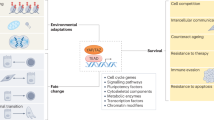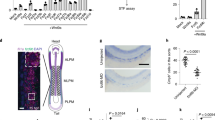Abstract
The hope of developing new transplantation therapies for degenerative diseases is limited by inefficient stem cell growth and immunological incompatibility with the host1,2. Here we show that Notch receptor activation induces the expression of the specific target genes hairy and enhancer of split 3 (Hes3) and Sonic hedgehog (Shh) through rapid activation of cytoplasmic signals, including the serine/threonine kinase Akt, the transcription factor STAT3 and mammalian target of rapamycin, and thereby promotes the survival of neural stem cells. In both murine somatic and human embryonic stem cells, these positive signals are opposed by a control mechanism that involves the p38 mitogen-activated protein kinase. Transient administration of Notch ligands to the brain of adult rats increases the numbers of newly generated precursor cells and improves motor skills after ischaemic injury. These data indicate that stem cell expansion in vitro and in vivo, two central goals of regenerative medicine, may be achieved by Notch ligands through a pathway that is fundamental to development and cancer3,4,5.
This is a preview of subscription content, access via your institution
Access options
Subscribe to this journal
Receive 51 print issues and online access
$199.00 per year
only $3.90 per issue
Buy this article
- Purchase on Springer Link
- Instant access to full article PDF
Prices may be subject to local taxes which are calculated during checkout




Similar content being viewed by others
References
Wakayama, T. et al. Differentiation of embryonic stem cell lines generated from adult somatic cells by nuclear transfer. Science 292, 740–743 (2001)
Xu, R. H. et al. Basic FGF and suppression of BMP signaling sustain undifferentiated proliferation of human ES cells. Nature Methods 2, 185–190 (2005)
Artavanis-Tsakonas, S., Rand, M. D. & Lake, R. J. Notch signaling: cell fate control and signal integration in development. Science 284, 770–776 (1999)
Cantley, L. C. The phosphoinositide 3-kinase pathway. Science 296, 1655–1657 (2002)
Levy, D. E. & Darnell, J. E. Jr Stats: transcriptional control and biological impact. Nature Rev. Mol. Cell Biol. 3, 651–662 (2002)
Goriely, A., Dumont, N., Dambly-Chaudiere, C. & Ghysen, A. The determination of sense organs in Drosophila: effect of the neurogenic mutations in the embryo. Development 113, 1395–1404 (1991)
Tokunaga, A. et al. Mapping spatio-temporal activation of Notch signaling during neurogenesis and gliogenesis in the developing mouse brain. J. Neurochem. 90, 142–154 (2004)
Hatakeyama, J. et al. Hes genes regulate size, shape and histogenesis of the nervous system by control of the timing of neural stem cell differentiation. Development 131, 5539–5550 (2004)
Johe, K. K., Hazel, T. G., Muller, T., Dugich-Djordjevic, M. M. & McKay, R. D. Single factors direct the differentiation of stem cells from the fetal and adult central nervous system. Genes Dev. 10, 3129–3140 (1996)
Franke, T. F. et al. The protein kinase encoded by the Akt proto-oncogene is a target of the PDGF-activated phosphatidylinositol 3-kinase. Cell 81, 727–736 (1995)
Dudek, H. et al. Regulation of neuronal survival by the serine-threonine protein kinase Akt. Science 275, 661–665 (1997)
Nave, B. T., Ouwens, M., Withers, D. J., Alessi, D. R. & Shepherd, P. R. Mammalian target of rapamycin is a direct target for protein kinase B: identification of a convergence point for opposing effects of insulin and amino-acid deficiency on protein translation. Biochem J. 344, 427–431 (1999)
Rajan, P. & McKay, R. D. Multiple routes to astrocytic differentiation in the CNS. J. Neurosci. 18, 3620–3629 (1998)
Yang, J. et al. Novel roles of unphosphorylated STAT3 in oncogenesis and transcriptional regulation. Cancer Res. 65, 939–947 (2005)
Pullen, N. et al. Phosphorylation and activation of p70s6k by PDK1. Science 279, 707–710 (1998)
Alessi, D. R., Kozlowski, M. T., Weng, Q. P., Morrice, N. & Avruch, J. 3-Phosphoinositide-dependent protein kinase 1 (PDK1) phosphorylates and activates the p70 S6 kinase in vivo and in vitro. Curr. Biol. 8, 69–81 (1998)
Deak, M., Clifton, A. D., Lucocq, L. M. & Alessi, D. R. Mitogen- and stress-activated protein kinase-1 (MSK1) is directly activated by MAPK and SAPK2/p38, and may mediate activation of CREB. EMBO J. 17, 4426–4441 (1998)
Lavoie, J. N., L'Allemain, G., Brunet, A., Muller, R. & Pouyssegur, J. Cyclin D1 expression is regulated positively by the p42/p44MAPK and negatively by the p38/HOGMAPK pathway. J. Biol. Chem. 271, 20608–20616 (1996)
Doetsch, F., Petreanu, L., Caille, I., Garcia-Verdugo, J. M. & Alvarez-Buylla, A. EGF converts transit-amplifying neurogenic precursors in the adult brain into multipotent stem cells. Neuron 36, 1021–1034 (2002)
Berman, D. M. et al. Medulloblastoma growth inhibition by hedgehog pathway blockade. Science 297, 1559–1561 (2002)
Romer, J. & Curran, T. Targeting medulloblastoma: small-molecule inhibitors of the Sonic Hedgehog pathway as potential cancer therapeutics. Cancer Res. 65, 4975–4978 (2005)
Kamakura, S. et al. Hes binding to STAT3 mediates crosstalk between Notch and JAK–STAT signalling. Nature Cell Biol. 6, 547–554 (2004)
Oishi, K. et al. Notch promotes survival of neural precursor cells via mechanisms distinct from those regulating neurogenesis. Dev. Biol. 276, 172–184 (2004)
Niwa, H., Burdon, T., Chambers, I. & Smith, A. Self-renewal of pluripotent embryonic stem cells is mediated via activation of STAT3. Genes Dev. 12, 2048–2060 (1998)
Watanabe, S. et al. Activation of Akt signaling is sufficient to maintain pluripotency in mouse and primate embryonic stem cells. Oncogene 25, 2697–2707 (2006)
Pera, M. F. et al. Regulation of human embryonic stem cell differentiation by BMP-2 and its antagonist noggin. J. Cell Sci. 117, 1269–1280 (2004)
Couillard-Despres, S. et al. Doublecortin expression levels in adult brain reflect neurogenesis. Eur. J. Neurosci. 21, 1–14 (2005)
Leker, R. R., Gai, N., Mechoulam, R. & Ovadia, H. Drug-induced hypothermia reduces ischemic damage: effects of the cannabinoid HU-210. Stroke 34, 2000–2006 (2003)
Zhao, Y., Patzer, A., Gohlke, P., Herdegen, T. & Culman, J. The intracerebral application of the PPARγ-ligand pioglitazone confers neuroprotection against focal ischaemia in the rat brain. Eur. J. Neurosci. 22, 278–282 (2005)
Gustafsson, M. V. et al. Hypoxia requires notch signaling to maintain the undifferentiated cell state. Dev. Cell 9, 617–628 (2005)
Acknowledgements
We thank R. Kageyama and T. Kitamura for the Hes3 and STAT3 plasmids. This research was supported in part by the Intramural Research Program of the NIH, NINDS.
Author information
Authors and Affiliations
Corresponding author
Ethics declarations
Competing interests
Reprints and permissions information is available at npg.nature.com/reprintsandpermissions. The authors declare no competing financial interests.
Supplementary information
Supplementary Figure 1
A schematic representation of this work. (PDF 154 kb)
Supplementary Figure 2
Notch ligands activate second messenger signalling and support NSC (E13.5) survival in vitro. (PDF 104 kb)
Supplementary Figure 3
Notch activation promotes the generation of adult NSC in vivo. (PDF 127 kb)
Supplementary Figure
This file contains the Supplementary Figure Legends and Supplementary Tables 1–3. (DOC 67 kb)
Rights and permissions
About this article
Cite this article
Androutsellis-Theotokis, A., Leker, R., Soldner, F. et al. Notch signalling regulates stem cell numbers in vitro and in vivo. Nature 442, 823–826 (2006). https://doi.org/10.1038/nature04940
Received:
Accepted:
Published:
Issue Date:
DOI: https://doi.org/10.1038/nature04940
This article is cited by
-
The Notch signaling pathway: a potential target for cancer immunotherapy
Journal of Hematology & Oncology (2023)
-
Effects of advanced glycation end products (AGEs) on the differentiation potential of primary stem cells: a systematic review
Stem Cell Research & Therapy (2023)
-
1′-O-methyl-averantin isolated from the endolichenic fungus Jackrogersella sp. EL001672 suppresses colorectal cancer stemness via sonic Hedgehog and Notch signaling
Scientific Reports (2023)
-
C5L2 modulates BDNF production in human dental pulp stem cells via p38α pathway
Scientific Reports (2023)
-
The Notch pathway regulates autophagy after hypoxic–ischemic injury and affects synaptic plasticity
Brain Structure and Function (2023)
Comments
By submitting a comment you agree to abide by our Terms and Community Guidelines. If you find something abusive or that does not comply with our terms or guidelines please flag it as inappropriate.



